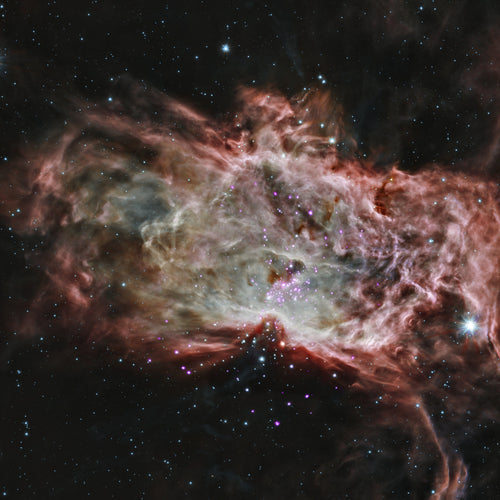
Astronz Object Of The Week: Flame Nebula
The Flame Nebula, cataloged as NGC 2024, is a remarkable emission nebula located within the Orion constellation, one of the most familiar and prominent features of the night sky. Found near Alnitak, the easternmost star in Orion’s Belt, this nebula is a fascinating target for amateur astronomers and astrophotographers.
What is the Flame Nebula?
The Flame Nebula lies about 1,350 light-years away, embedded in the Orion Molecular Cloud Complex—a vast stellar nursery containing several well-known nebulae. Its glowing appearance is caused by ultraviolet radiation from nearby stars, which ionizes the surrounding hydrogen gas, creating a characteristic reddish emission. Dark bands of interstellar dust cross the nebula, giving it a distinct structure that resembles the flickering flames of a fire. These dust lanes both obscure and reveal parts of the nebula, adding to its visual complexity.
At the heart of the nebula lies a young cluster of stars, which contributes to the ionization and heating of the surrounding gas. Many of these stars are still shrouded by thick clouds of dust, making the nebula an active region of ongoing star formation.
Finding the Flame Nebula in the Sky
This week, the Flame Nebula is well-placed for evening observation. Here’s how to locate it:
- Start with Orion’s Belt: Look for the three bright stars forming a straight line in the eastern night sky. These are Alnitak, Alnilam, and Mintaka.
- Focus on Alnitak: The nebula is located just below and slightly to the southeast of Alnitak, the leftmost star in the Belt (from a Northern Hemisphere perspective).
- Use a Telescope: The Flame Nebula is faint and requires optical aid for observation. While binoculars might not reveal much detail, a small telescope with a low-power eyepiece will help bring it into view.
Observing Tips
- Dark Skies are Key: The Flame Nebula’s faint glow is best observed under dark-sky conditions, away from light pollution. Look for a night with good transparency and minimal atmospheric interference.
- Equipment: A telescope with an aperture of 6 inches or more is ideal for capturing the details of the nebula. Adding a UHC (Ultra-High Contrast) or OIII filter can enhance the nebula’s visibility by reducing the impact of surrounding light.
- Timing: The Orion constellation rises in the east during early evening and climbs higher into the sky by midnight, offering a stable window for observation.
Scientific Insights
The Flame Nebula is not just visually stunning—it’s scientifically fascinating. It lies within a star-forming region dominated by intense radiation and powerful stellar winds. These forces sculpt the intricate shapes we see in the nebula and drive the formation of new stars. Additionally, the interplay of bright emission regions and dark dust lanes provides astronomers with a natural laboratory to study how stars form in environments rich with interstellar material.
Neighboring Objects
While you’re observing the Flame Nebula, take the opportunity to explore its cosmic neighborhood. It lies near the famous Horsehead Nebula (Barnard 33), another striking target for telescopes and cameras. Both are part of the larger Orion Molecular Cloud Complex, a region teeming with celestial wonders.
This week, as Orion dominates the northeastern sky, challenge yourself to find the Flame Nebula. Whether you’re viewing it through a telescope or photographing it, this cosmic “flame” offers a glimpse into the dynamic processes shaping our universe.
